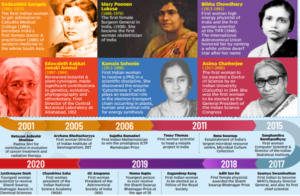Invisible Women in Science.
Relevance
- GS Paper- 1 Role of women and women’s organization, population and associated issues, poverty and developmental issues, urbanization, their problems and their remedies.
- Achievements of Indians in science & technology; indigenization of technology and development of new technology.
- Tags: #women #science #discrimination #inequality #currentaffairs #upsc.
Why in the news?
The Shanti Swarup Bhatnagar Prize, a prestigious accolade for scientists, not only elevates the recipient’s scientific career but also enhances the reputation of their institution. However, it has earned notoriety for consistently overlooking women scientists since its inception in 1958. This article sheds light on the persisting gender bias in the awarding of Bhatnagar Prizes.
A Long History of Exclusion
- Asima Chatterjee’s victory in the Chemical Sciences category in 1961 marked a watershed moment, but her triumph was followed by a disheartening 14-year gap before the next woman laureate emerged.
- Furthermore, it took 48 years for another woman to claim this award in her category, with Charusita Chakravarty’s win in 2009.
- This year’s announcement, for the second consecutive time, featured an all-male cohort of winners, with no woman scientist deemed to have made an “outstanding contribution to science and technology.” Out of nearly 600 Bhatnagar Prizes awarded, only 19 have been conferred upon women scientists.
The Fallacy of Insufficient Representation
- The argument that there aren’t enough women in the field, given that they constitute approximately 14 percent of India’s working scientists, is debunked by these statistics. It suggests that the gender disparity lies elsewhere.
The Opaque Selection Process
- The opaqueness of the selection process is often the root cause of this underrepresentation. Eligibility for a Bhatnagar Prize depends on nominations from individuals at the highest echelons of academia and research, such as vice-chancellors, directors, academy presidents, deans, governing body members of CSIR, and previous laureates.
- Unfortunately, these positions are predominantly held by men, resulting in an evident failure to nominate their female colleagues.
Hope for Change: A Transparent Path Forward
- The revamp of the Bhatnagar Awards is currently underway, offering a glimmer of hope.
- Transparency in the nomination and advisory committee selection process is imperative for progress.
- The Nobel Prizes, despite their shortcomings, have made some strides in this direction by eventually revealing information about nominations and advisory committees, allowing for data-driven strategies to address gender disparities.
Taking Cues from Other Initiatives
- Comparatively, the Royal Swedish Academy of Sciences, which awards the Nobel Prizes, has shown awareness of its gender gap, with 31 out of 61 prizes for women across all categories since 2000. This indicates that progress can be achieved when concerted efforts are made.
CSIR’s Responsibility: Leading the Change
- As India’s largest R&D organization with over 4,000 scientists, CSIR has a moral obligation not to remain indifferent to the issue of women’s underrepresentation in science.
- Initiatives like appointing N Kalaiselvi as its chief and conducting a gender parity survey demonstrate the organization’s commitment to addressing the issue.
Transparency as a Catalyst for Progress
- CSIR should follow the example of the Infosys Science Prize, which publicly lists its jury chairs on its website, promoting transparency and accountability. Without public accountability, it is challenging to bridge the gender gap in the scientific community.
A Call for Accountability
- The discourse surrounding women in science has gained momentum, but accountability for the issues affecting women scientists’ careers remains scarce.
- To achieve inclusivity in the Indian science community, ageism, casteism, sexism, and the dominance of old boys’ clubs must be challenged and dismantled.
In conclusion, recognizing the invaluable contributions of women in science is a critical step toward achieving gender equity in the field. The Shanti Swarup Bhatnagar Prize, as a symbol of scientific excellence, must lead the way by ensuring that gender bias is eradicated from its selection process, paving the path for a more equitable future for women in Indian science.
| Challenges commonly faced by women in the field of science
· Gender Bias: Women often encounter gender bias in hiring, promotions, and recognition, which can limit their career progression and opportunities. · Underrepresentation: Women are often underrepresented in leadership positions, research funding, and scientific conferences, which hinders their visibility and influence in the field. · Work-Life Balance: Balancing demanding research careers with family responsibilities can be challenging, leading to fewer women pursuing or persisting in scientific careers. · Stereotypes: Stereotypes about gender roles and abilities can discourage women from pursuing certain scientific disciplines or can affect how their contributions are perceived. · Harassment and Discrimination: Women in science may face harassment, discrimination, and hostile work environments, which can lead to psychological and professional setbacks. · Lack of Role Models: The scarcity of female role models in science can make it difficult for women to envision successful scientific careers and can deter them from entering the field. Government initiatives to promote gender equity, support women scientists, and encourage women’s participation in science and technology include: Gender Advancement for Transforming Institutions (GATI) · This is a pilot project initiated by the Department of Science and Technology with the aim of fostering gender equity in the fields of science and technology. Knowledge Involvement in Research Advancement through Nurturing (KIRAN) · KIRAN, also under the Department of Science and Technology, is designed to empower and encourage women scientists in the realm of science and technology. It addresses challenges such as women scientists leaving research due to family reasons. Women Scientist Scheme (under KIRAN) · This program, a part of KIRAN, provides career opportunities specifically to unemployed women scientists and technologists, particularly those who have had career breaks. Indo-US Fellowship for Women in STEMM (WISTEMM) · Facilitated by a bilateral agreement, this program enables Indian women scientists to work in research laboratories in the United States, promoting international collaboration and exposure. Consolidation of University Research for Innovation and Excellence in Women Universities (CURIE) · CURIE is a program aimed at enhancing research and development infrastructure and establishing cutting-edge research facilities in women’s universities, with the goal of fostering excellence in science and technology. Vigyan Jyoti Programme · This program encourages meritorious girl students in grades 9-12 to pursue higher education and careers in the STEM (Science, Technology, Engineering, and Mathematics) fields, opening doors to opportunities in science and technology. |
Sources: Indian Express.
Mains Question.
“Discuss the key challenges encountered by women in the field of science, including gender bias, limited representation in leadership roles, work-life balance issues, and societal stereotypes. Analyze the impact of these challenges on women’s participation and advancement in scientific careers, and propose strategies to promote gender diversity and equality in the scientific community.” 250words.





